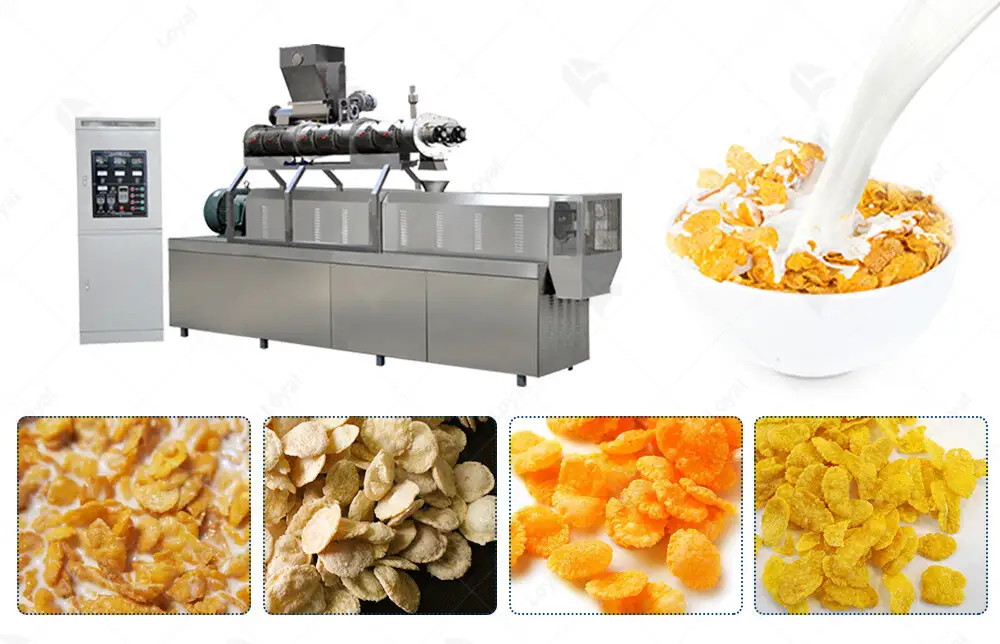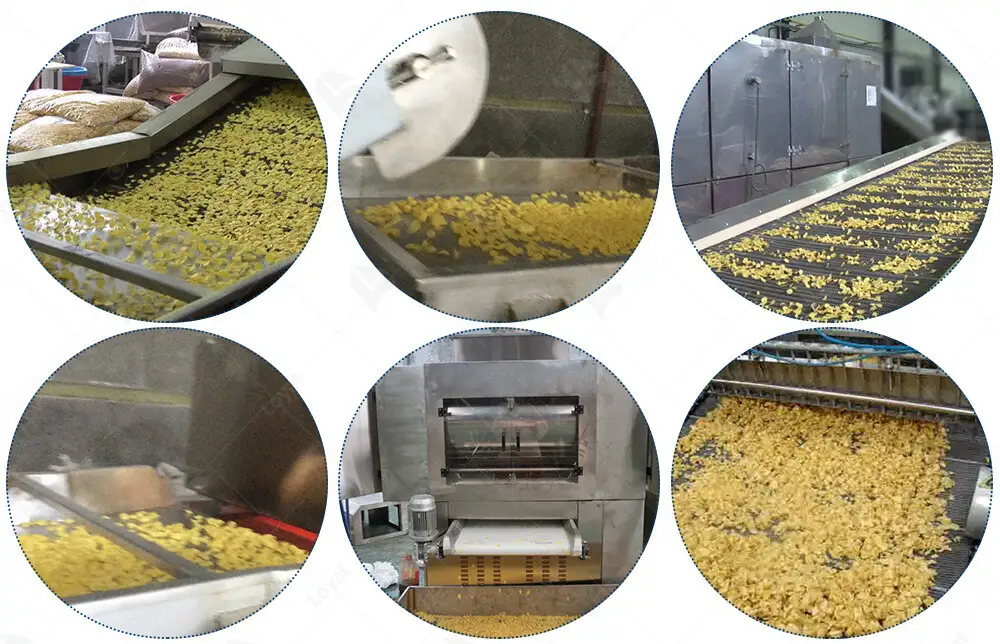Everything You Need To Know About Corn Extruder Machine
Introduction
In the vast landscape of food processing machinery, the Corn Extruder Machine stands out as a pivotal piece of equipment for transforming raw corn into a multitude of value-added products. As an industrial food mechanics expert, I am often asked to elaborate on the intricacies and benefits of this remarkable technology. Simply put, a Corn Extruder Machine is a mechanical device designed to extrude corn meal or dough under high pressure through a die, thereby shaping and forming it into various desired shapes and sizes. This process not only enhances the nutritional profile and texture of corn-based foods but also opens up a myriad of possibilities for innovation in the food industry.
The core functionality of a Corn Extruder Machine revolves around its ability to exert considerable force on the corn material, forcing it through a precisely engineered die. This extrusion process involves a combination of heat, pressure, and shear forces, which alter the physical and chemical properties of the corn. The result is a dense, textured product that retains its shape and structure, making it ideal for a wide range of applications. From corn snacks and breakfast cereals to pet foods and texturized vegetable proteins, the versatility of the Corn Extruder Machine is unmatched.
Moreover, the advent of modern technology has significantly enhanced the capabilities of these machines. Advanced models now incorporate automated controls, precision temperature regulation, and variable feed rates, allowing for greater precision and consistency in the extrusion process. This level of control is crucial for maintaining product quality, enhancing food safety, and optimizing production efficiency.
As the demand for convenient, nutritious, and innovative food products continues to grow, the role of the Corn Extruder Machine in the food industry becomes increasingly significant. Whether you are a seasoned food manufacturer or a startup looking to explore the potential of corn-based products, understanding the fundamentals and advanced features of this machinery is essential. In the following sections, we will delve deeper into the working principles, types, benefits, and considerations for selecting the right Corn Extruder Machine for your needs. Stay tuned to uncover all you need to know about this indispensable tool in the world of food processing.

Working Principle of Corn Extruder
Understanding the working principle of a Corn Extruder Machine is crucial for anyone involved in the food processing industry, especially when it comes to manufacturing corn-based products. As an industrial food machinery expert, I'll break down the core components and operational steps of this versatile equipment, ensuring clarity and precision.
Core Components of a Corn Extruder Machine
A Corn Extruder Machine consists of several key components that work harmoniously to transform raw corn into various textured and shaped products. These components include:
Feed Hopper: This is where the raw corn material is loaded into the machine. It should be designed to handle bulk quantities efficiently while ensuring smooth feeding into the extruder screw.
Extruder Screw: Often referred to as the auger, this is the heart of the extruder. It rotates inside a barrel, pushing the raw material forward while applying pressure and heat. The screw's design, with its varying pitch and flight sections, is crucial for mixing, kneading, and extruding the material.
Barrel: The barrel houses the extruder screw and provides a controlled environment for the material to undergo plastic deformation. It's typically heated and cooled to maintain the desired temperature profile, which is essential for achieving the right product texture and moisture content.
Die Plate: At the end of the barrel, the die plate shapes the extruded material into the desired form. Dies can have various hole patterns, sizes, and shapes, allowing for the production of a wide range of products, from corn pasta to snack pellets.
Cooling and Cutting Mechanism: Immediately after extrusion, the hot, plasticized material needs to be cooled and cut into the final product size. This is often achieved using water baths or air cooling followed by a cutting device that slices the continuous extrudate into manageable pieces.
Operational Steps of a Corn Extruder Machine
Feeding: Raw corn material, which may be pre-processed (e.g., ground, moistened, or blended with other ingredients), is loaded into the feed hopper. The material is gravity-fed or mechanically conveyed into the extruder screw.
Conditioning: As the material enters the extruder screw, it begins to be compressed and heated. The screw's design ensures that the material is evenly distributed and mixed, creating a homogeneous mass. This step is crucial for achieving a consistent product quality.
Extrusion: As the material moves through the barrel, it undergoes plastic deformation due to the combined effects of pressure, shear, and heat. The extruder screw pushes the material forward, forcing it through the die plate. The pressure applied during this stage is what gives the extruded product its shape and firmness.
Cooling and Shaping: Once the material exits the die plate, it is still hot and soft. It immediately enters a cooling system, which can be a water bath or air cooling system. This rapid cooling solidifies the product, giving it its final shape and texture.
Cutting and Packaging: After cooling, the continuous extrudate is cut into the desired lengths or sizes using a cutting mechanism. The cut products are then conveyed to a packaging station where they are prepared for distribution.
Key Considerations for Optimal Performance
To ensure the Corn Extruder Machine operates efficiently and produces high-quality products, several factors need to be considered:
Material Composition: The formulation of the raw material plays a significant role in the final product's quality. The moisture content, particle size, and ingredient proportions should be carefully controlled.
Temperature Profile: Maintaining the correct temperature profile within the barrel is essential for achieving the desired product texture and moisture content. Excessive heat can lead to product degradation, while insufficient heat may result in poor extrusion.
Screw Design: The extruder screw's design, including its pitch, flight sections, and mixing elements, can significantly impact the mixing efficiency, product homogeneity, and extrusion force.
Die Selection: The choice of die plate determines the shape, size, and texture of the final product. It's crucial to select the right die for the target application, ensuring it matches the extruder's capacity and the desired product specifications.

Advances and Innovations in Corn Extruder Technology
In the realm of food machinery, the Corn Extruder Machine has undergone significant advancements and innovations, transforming its capabilities and efficiency. As an industrial food machinery expert, it's crucial to stay abreast of these developments to provide accurate and authoritative insights. Below is a detailed overview of the latest advancements and innovations in corn extruder technology, presented in a structured table format for clarity.
Advancement/Innovation | Description | Impact on Corn Extrusion |
High-Precision Control Systems | Modern corn extruders are equipped with advanced control systems featuring PLCs (Programmable Logic Controllers) and HMI (Human-Machine Interfaces). These systems enable precise control over extrusion parameters such as temperature, pressure, and feed rate. | Enhanced precision leads to improved product quality, consistency, and reduced waste. It also allows for greater flexibility in producing a wider range of products. |
Variable Screw Designs | Innovations in screw design, including modular and interchangeable screws, have revolutionized corn extrusion. These designs allow for easy adjustment and optimization of the extrusion process based on different product requirements. | Variable screw designs enhance the versatility of the machine, enabling it to handle a variety of corn types and formulations. This results in improved product texture, taste, and nutritional profile. |
Energy-Efficient Motors and Drives | Manufacturers have incorporated energy-efficient motors and drives into corn extruder designs. These components reduce power consumption and operational costs while maintaining high performance. | The adoption of energy-efficient technology aligns with the industry's commitment to sustainability. It also contributes to lower long-term operational expenses for food processors. |
Advanced Heating and Cooling Systems | The integration of advanced heating and cooling systems ensures precise temperature control during the extrusion process. These systems utilize high-efficiency heaters and chillers to maintain optimal operating temperatures. | Accurate temperature control is crucial for achieving desired product characteristics such as texture, moisture content, and shelf life. It also helps prevent thermal degradation and ensures product safety. |
Automated Feeding and Discharge Mechanisms | Automated feeding and discharge systems have been developed to streamline the extrusion process. These systems reduce manual intervention, improving productivity and reducing labor costs. | Automation enhances the overall efficiency of the corn extruder, enabling food processors to produce larger quantities of high-quality products in shorter timeframes. |
Smart Monitoring and Diagnostics | Modern corn extruders are equipped with smart monitoring and diagnostic tools. These tools provide real-time data on machine performance and alert operators to potential issues before they escalate into costly repairs. | Predictive maintenance capabilities reduce unexpected downtime and extend the lifespan of the machine. They also contribute to a safer working environment by identifying and addressing potential hazards promptly. |
Sustainable Materials and Designs | Manufacturers are increasingly adopting sustainable materials and designs in corn extruder construction. This includes the use of recyclable materials, energy-efficient components, and modular designs that facilitate easy maintenance and upgrades. | Sustainable practices align with consumer demands for environmentally friendly products. They also contribute to reducing the carbon footprint of food production processes. |
Integration with Other Processing Equipment | Corn extruders are now designed to integrate seamlessly with other processing equipment, such as mixers, dryers, and packaging machines. This integration streamlines production workflows and enhances overall process efficiency. | Seamless integration reduces handling time and minimizes product loss during transfer between equipment. It also allows for greater flexibility in designing customized production lines tailored to specific product requirements. |

Market Trends and Demands of Corn Extruder Machine
In the ever-evolving landscape of food processing machinery, the Corn Extruder Machine has emerged as a pivotal piece of equipment, catering to the growing demands of the food industry. As an industrial food machinery expert, it's crucial to understand the market trends and demands driving the adoption of this technology. Here's an in-depth look at the current state and future projections for corn extruders.
Growing Consumer Preference for Healthy Snacks
One of the most significant market trends influencing the demand for Corn Extruder Machines is the increasing consumer preference for healthy snacks. With health consciousness at an all-time high, consumers are seeking alternatives to traditional, processed foods. Corn-based snacks, such as extruded corn chips and puffed corn, are perceived as healthier options due to their minimal processing and whole-grain content. This shift in consumer behavior has led to a surge in demand for corn extruder machines, as manufacturers strive to meet the growing appetite for healthier snack options.
Expansion of the Organic Food Market
The organic food market is experiencing exponential growth, fueled by consumer concerns about the environmental impact of conventional farming practices and the potential health risks associated with pesticides and genetically modified organisms (GMOs). Corn extruder machines play a crucial role in the production of organic snacks, as they can process organic corn without compromising the integrity of the organic certification. This trend is expected to continue, driving further demand for corn extruder technology that can handle organic ingredients efficiently.
Technological Advancements in Extrusion Technology
The food machinery industry is constantly innovating, and corn extruder machines are no exception. Manufacturers are continuously investing in research and development to enhance the functionality and efficiency of their machines. Recent advancements in extrusion technology include improved temperature control, more precise ingredient metering, and enhanced die designs that allow for the production of a wider variety of shapes and sizes. These technological improvements are not only increasing the quality and consistency of the final product but also making corn extruder machines more versatile and adaptable to different production needs.
Sustainability and Environmental Concerns
In today's world, sustainability is a top priority for both consumers and businesses. Corn extruder machines contribute to more sustainable food production practices by reducing waste and minimizing the use of energy and water. By utilizing by-products and waste materials from other food processing operations, corn extruder manufacturers can create value-added products while promoting circular economy principles. Additionally, advancements in extrusion technology are enabling the production of plant-based alternatives to meat and dairy products, which have a lower carbon footprint compared to traditional animal-based foods.
Globalization and Export Opportunities
The globalization of the food industry has opened up new export opportunities for corn extruder machine manufacturers. As emerging markets in Asia, Africa, and Latin America continue to develop, the demand for processed food products is increasing. Corn extruder machines are well-suited to these markets, as they can be used to produce a wide range of affordable and nutritious food products that cater to local tastes and preferences. By exporting their machines to these regions, manufacturers can tap into new revenue streams and expand their global footprint.

Maintenance of Corn Extruder Machine
Regular Inspection and Cleaning
1. Daily Checks:Start your maintenance routine with daily inspections. Check for any visible signs of wear, such as cracks in the barrel or worn-out screws. Ensure that all belts and pulleys are tensioned correctly and that there are no leaks in the hydraulic system.
2. Thorough Cleaning:Cleanliness is paramount in food processing. Regularly clean the extruder barrel, die, and screws using food-grade cleaning agents. Remove any built-up residue to prevent contamination and maintain efficient heat transfer. Pay special attention to the cooling system, ensuring it's free from debris that could impede its function.
Lubrication and Wear Parts Replacement
3. Lubrication:Proper lubrication of moving parts is crucial for reducing friction and wear. Use high-quality lubricants recommended by the manufacturer and follow the specified lubrication schedule. Ensure that bearings, gears, and slides are adequately lubricated to prevent premature failure.
4. Wear Parts Replacement:Over time, wear parts such as screws, barrels, and dies will wear out. Regularly inspect these components for signs of wear and replace them as needed. Using genuine manufacturer parts ensures compatibility and maintains the machine's performance standards.
Hydraulic and Electrical System Maintenance
5. Hydraulic System:The hydraulic system is the heart of the Corn Extruder Machine. Regularly check hydraulic oil levels and quality, replacing it as per the manufacturer's recommendations. Inspect hoses and fittings for leaks and replace any worn-out components immediately. Keep the hydraulic system clean to prevent contamination and ensure smooth operation.
6. Electrical System:The electrical system controls the operation of the extruder. Regularly inspect electrical connections, relays, and sensors for signs of corrosion or damage. Ensure that the motor is running within its specified parameters and that overheating is prevented by adequate ventilation. Conduct periodic preventive maintenance on the electrical panel, following all safety protocols.
Temperature and Pressure Control
7. Temperature Monitoring:Accurate temperature control is vital for achieving the desired product quality. Regularly check the heating elements and temperature sensors to ensure they are functioning correctly. Use a calibrated thermometer to verify the actual temperatures inside the extruder barrel and adjust as necessary.
8. Pressure Regulation:Pressure is another critical factor in the extrusion process. Monitor the pressure gauges regularly and ensure they are accurate. Adjust the pressure settings as per the recipe requirements and the machine's specifications to maintain consistent product quality.
Preventive Maintenance Schedule
9. Establishing a Schedule:Creating a preventive maintenance schedule is the cornerstone of effective maintenance. Tailor the schedule to your specific needs, taking into account the machine's usage, age, and operating conditions. Regularly review and update the schedule to incorporate any new maintenance practices or technologies.
By adhering to this comprehensive maintenance guide, you can ensure that your Corn Extruder Machine operates efficiently, produces high-quality products, and remains reliable for years to come. Remember, proactive maintenance is always more cost-effective than reactive repairs. Stay ahead of potential issues and keep your food processing operations running smoothly with a well-maintained Corn Extruder Machine.

Reference
Here are five authoritative foreign websites related to industrial food machinery, along with their URLs:
1.ThomasNet
Website: https://www.thomasnet.com
2.MachineryTrader
Website: https://www.machinerytrader.com
3.Food Engineering:https://www.foodengineeringmag.com
4.Pack Expo:https://www.packexpo.com
5.DirectIndustry:https://www.directindustry.com












